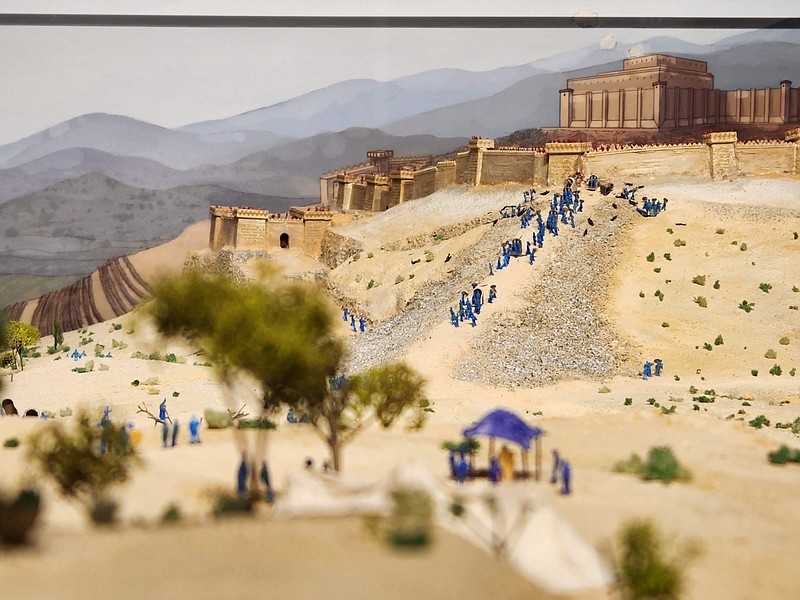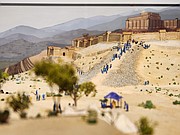COLLEGEDALE — Thousands of years ago, the kingdom of Judah was under attack. Among the few remaining records of that? The Bible, which says an angel vanquished the troops of an aggressive Assyrian king — and thus miraculously saved the city of Jerusalem.
Records produced by that attacking king, Sennacherib, centered a different, perhaps more personally flattering story, however. An elaborate display found in the ruins of his ancient palace focused not on his failure in Jerusalem, but rather on his successful conquest of a prominent nearby city: Lachish.
Lachish, which itself receives only passing mention in the Bible, has for years been studied by researchers from Southern Adventist University in Collegedale, who, through excavations and analysis, sought to learn more about that Old Testament time and place through the pottery, tools and detritus its people left behind.
(READ MORE: Chattanooga area researchers' find leads to major discovery)
Among their finds was an ivory lice comb, carrying what may be the oldest complete sentence yet found in the ancient Canaanite writing system -- a precursor to the modern alphabet.
Now, the university has opened an exhibit at its campus featuring many other finds from the excavation. The exhibit depicts the daily life and destruction of Lachish, the archaeological efforts that helped bring that history to light, as well as the challenges of deciphering an elusive and sparsely preserved historical record, itself inevitably shaped by interested parties of the past.
"Archaeology is often a lot of guesswork," said Michael Hasel, who directs the university's Institute of Archaeology and co-led the excavation.
At the exhibit Monday, he said the historical record of Lachish comes from an uncommon diversity of sources -- and thus its story can be told in an uncommonly balanced way.
Lachish had been the subject of three prior archaeological expeditions, all of which were disrupted by the ongoing tumult of a politically unstable region.
For example, the British archaeologist who led the first expedition was murdered in 1938, during the sixth digging season, when his car was ambushed. The motives remain unclear, the Southern Adventist University exhibit said.
Hasel's own five-year expedition was itself disrupted in 2014, when hundreds of rockets flew overhead from Gaza amid escalating tensions in the region, Hasel remembered. The researchers evacuated and left their work for the next year.
Archaeological digs often take place slowly, as workers comb through stratified layers of earth, which generally correspond to specific time periods. For years, Southern Adventist University students along with counterparts from research institutions around the world awoke at 4 a.m. for long days of digging and mapping and organizing before passing their findings to professional researchers like Hasel for further analysis.
That analysis has been taking place ever since -- and one of its early products is the new exhibit titled "Peace and War: The Assyrian Conquest of Lachish."
Though the team's excavation efforts focused in part on prior, lesser known periods, the exhibit centers on a time depicted extensively in the Book of Isaiah and other Old Testament texts: the Assyrian invasion of a region standing between it and Egypt, the other great nearby empire of the time.
Judah formed the southern part of that buffer region, and attackers came through Lachish and other cities before making their way to Jerusalem, where, according to the Bible, they were defeated with divine help.
After the discussion of archaeological history, the exhibit depicts life in peacetime Lachish, showcasing tools of commerce such as looms or domestic life such as bowls.
The exhibit was mapped out before the arrival of the objects themselves, which are on loan from the Israel Antiquities Authority until May of 2025, for the duration of the exhibit, Hasel said.
The objects were flown via Lufthansa Airlines to Atlanta before being driven to the university along with a high-ranking Israeli courier.
Forklifts were ready when the projects arrived, Hasel said. The objects had to remain in their specialized packaging for a couple of days as they adjusted to the new climate, before they were opened and arranged near the plaques that had, generally, already been written and placed, Hasel said.
By around 700 BCE, the Assyrians, who had already swept through Northern Israel, had their sights on Judah. In the Biblical account, the prophets warned the king of Judah, Hezekiah, that the wicked faith systems running rampant through his land would sow its destruction.
The Bible notes Hezekiah's efforts to root out rogue worship, Hasel said, "but he evidently didn't get rid of it completely."
The Assyrians attacked Judah and burned much of it to the ground, as was their custom.
After Jerusalem, Judah's next most prominent city was Lachish, Hasel said. The exhibit shows a three-dimensional model of the battle for the city, as well as physical remnants researchers unearthed, like slingshot balls and armor.
The exhibit also, of course, displays the historical records left by Sennacherib, the Assyrian king, whose old palace around present-day Iraq featured displays prominently and vividly depicting the battle for Lachish.
Those and other records from the Assyrian king tend to to be triumphalist in nature. His army continued toward Jerusalem, Hasel said. Though they were ultimately defeated, in his annals recounting the events in Judah, the Assyrian king describes his counterpart sitting in Jerusalem, like a bird in a cage.
The Assyrian record goes no farther, Hasel said.
"And the Biblical record says, 'yeah, but that was for one night.'"
Contact Andrew Schwartz at aschwartz@timesfreepress.com or 423-757-6431.

